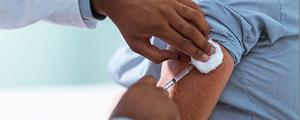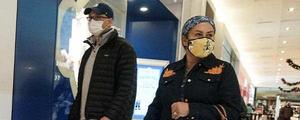Story Highlights
- 73% in U.S. say coronavirus situation is getting worse, up 12 points
- 50%, up from 33%, worry about availability of hospital supplies, treatment
- 72% say lives disrupted by pandemic; 87% say it will last well into 2021
WASHINGTON, D.C. -- As the U.S. continues to set records for coronavirus cases, hospitalizations and deaths, Americans' perceptions that the situation is worsening have risen to match the previous high point of 73%, even as the U.S. is on the verge of approving COVID-19 vaccines. Findings from Gallup's Nov. 16-29 COVID-19 tracking survey also include an increase in the public's concern about the availability of hospital supplies, services and treatment, from 33% to 50%.
Nearly three in five U.S. adults remain worried about personally contracting the disease, but concerns about the availability of COVID-19 testing and a lack of social distancing in their area are stable at significantly lower levels.
More than seven in 10 Americans continue to report in the online survey that their lives have been disrupted by the pandemic, and the public widely expects the disruption to continue through at least the first half of 2021.
Views of the U.S. Coronavirus Situation Tie Worst on Record
Gallup has tracked Americans' views of the coronavirus situation in the U.S. in its probability-based online survey since early April, when 56% said it was getting worse. Since then, it has fluctuated, but the latest percentage, 73%, who say it is worsening ties the highest on record. That occurred in July, when COVID-19 cases were rising in many parts of the U.S. The latest reading includes 53% who say the situation is getting "a lot" and 20% "a little" worse, roughly the same as the July readings.

Line graph. Americans' views of the coronavirus situation in the U.S. today, trend since April 6. Currently, 73% of U.S. adults say it is getting a lot or a little worse, 12% think it is getting a lot or a little better, and 15% say it is staying about the same.
Throughout the trend, Democrats have been much more likely than Republicans to say the situation is getting worse. In the latest survey, 95% of Democrats, 71% of independents and 46% of Republicans think the pandemic is worsening. Twenty-six percent of Republicans say the situation is getting better and 29% say it is staying the same.
Hospital Capacity Worries Rising; Testing, Social Distancing Worries Stable
In early April, hospitals in some parts of the U.S. were stretched thin because of overwhelming patient loads, and 64% of Americans were "very" or "moderately" worried about the availability of hospital treatment, services and supplies in their area. As the curve began to flatten, the level of worry dropped, but it rose again -- though to a lower level (48%) -- in July, when hospitalizations once again increased.
With hospitalizations of COVID-19 patients now higher than ever before, Americans' level of worry about hospital capacity in their local areas has almost doubled since September. Still, the 50% of U.S. adults who currently are worried remains well below the levels in the early days of the pandemic.

Line graph. Percentage of Americans who are very or moderately worried about the availability of hospital supplies, services and treatment since April 6. Currently, half of U.S. adults say they are worried about their availability, up 17 percentage points since October.
Partisans' views -- which differ vastly across most measures related to the pandemic -- diverge in their level of concern about hospital capacity too -- 71% of Democrats, 49% of independents and 20% of Republicans are worried.
In contrast, the percentage of Americans who are very (5%) or moderately (22%) worried about the availability of testing for COVID-19 in their area is well below late April's 62% high. The reading has been stable since September.
At the same time, 46% of Americans express at least a moderate amount of worry about a lack of social distancing in their local area. This has not varied much since early April.
Worry About Getting COVID-19 Steady
Concern about personally contracting COVID-19 has fluctuated between 46% and 59% since the first reading in early April; it is currently at the upper end of that range, with 58% saying they are "very" or "somewhat" worried.

Line graph. Percentage of Americans who are very or moderately worried about getting COVID-19, trend since April 6. Currently, 58% say they are worried.
Most Say Lives Disrupted, Expect Pandemic to Continue Well Into 2021
Just over seven in 10 U.S. adults say their lives have been disrupted "a great deal" (25%) or "a fair amount" (47%). Readings on this measure have been largely stable since mid-April after hitting highs between 75% and 81% earlier in the pandemic.
Asked how long they expect the current level of disruption to continue, 56% of U.S. adults think it will be through the first six months of 2021, and 31% say longer than that. Only 2% think there are just a few weeks left in the disruption, and 11% say it will be a few more months. As the months have gone by, Americans have become more likely to think it will last longer.
While majorities of Americans across party lines think the disruption will continue at least through the first half of 2021, Republicans are more are likely than Democrats and independents to expect a quicker resolution, with 27% saying it will last no longer than a few months.
| U.S. adults | Republicans | Independents | Democrats | ||||||||||||||||||||||||||||||||||||||||||||||||||||||||||||||||||||||||||||||||||||||||||||||||
|---|---|---|---|---|---|---|---|---|---|---|---|---|---|---|---|---|---|---|---|---|---|---|---|---|---|---|---|---|---|---|---|---|---|---|---|---|---|---|---|---|---|---|---|---|---|---|---|---|---|---|---|---|---|---|---|---|---|---|---|---|---|---|---|---|---|---|---|---|---|---|---|---|---|---|---|---|---|---|---|---|---|---|---|---|---|---|---|---|---|---|---|---|---|---|---|---|---|---|---|
| % | % | % | % | ||||||||||||||||||||||||||||||||||||||||||||||||||||||||||||||||||||||||||||||||||||||||||||||||
| A few more weeks | 2 | 6 | 2 | 0 | |||||||||||||||||||||||||||||||||||||||||||||||||||||||||||||||||||||||||||||||||||||||||||||||
| A few more months | 11 | 21 | 9 | 5 | |||||||||||||||||||||||||||||||||||||||||||||||||||||||||||||||||||||||||||||||||||||||||||||||
| Through the first half of 2021 | 56 | 47 | 54 | 62 | |||||||||||||||||||||||||||||||||||||||||||||||||||||||||||||||||||||||||||||||||||||||||||||||
| Longer than that | 31 | 26 | 35 | 33 | |||||||||||||||||||||||||||||||||||||||||||||||||||||||||||||||||||||||||||||||||||||||||||||||
| GALLUP PANEL, Nov. 16-29, 2020 | |||||||||||||||||||||||||||||||||||||||||||||||||||||||||||||||||||||||||||||||||||||||||||||||||||
Learn more about how the Gallup Panel works.




